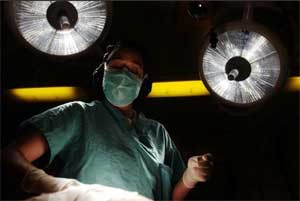- Home
- Editorial
- News
- Practice Guidelines
- Anesthesiology Guidelines
- Cancer Guidelines
- Cardiac Sciences Guidelines
- Critical Care Guidelines
- Dentistry Guidelines
- Dermatology Guidelines
- Diabetes and Endo Guidelines
- Diagnostics Guidelines
- ENT Guidelines
- Featured Practice Guidelines
- Gastroenterology Guidelines
- Geriatrics Guidelines
- Medicine Guidelines
- Nephrology Guidelines
- Neurosciences Guidelines
- Obs and Gynae Guidelines
- Ophthalmology Guidelines
- Orthopaedics Guidelines
- Paediatrics Guidelines
- Psychiatry Guidelines
- Pulmonology Guidelines
- Radiology Guidelines
- Surgery Guidelines
- Urology Guidelines
A rare case of anaphylaxis to ruptured roundworm during surgery

A rare case of anaphylaxis during operation has been published in the Indian Journal of Anaesthesiology. Dr Rajnish Kumar at Department of Anesthesiology, All India Institute of Medical Sciences, Patna, Bihar India and colleagues have reported the case.
The patent was a 15-year-old female a known case of chronic pancreatitis scheduled for surgery lateral pancreaticojejunostomy. She had no history of drug allergy and received ceftriaxone 1 g intravenously after skin sensitivity test approximately 30 min before surgery.
In the operating room, non-invasive monitors were attached, and after securing intravenous line Ringer's lactate was started. Her baseline vital parameters were normal. Thoracic epidural catheter was inserted at T11–12 intervertebral space in the sitting position followed by a test dose which was negative.
General anaesthesia was induced with intravenous (iv) inj. fentanyl 2 μg/kg and iv inj. propofol 80 mg and tracheal intubation was facilitated by giving iv inj. vecuronium. Anaesthesia was maintained with oxygen, air, sevoflurane, and vecuronium. Epidural analgesia was given with 0.25% of 10 mL bupivacaine.
The patient developed sudden tachycardia, with a heart rate of 150 beats/min and blood pressure below 80/50 mm Hg approximately 2 h after the start of anaesthesia. As an emergency measure, rapid infusion of Ringer's lactate along with phenylephrine 40 μg twice was given for hypotension. An increase in airway pressure was noted followed by a decrease in oxygen saturation below 70% and bluish discolouration of bowel.
Bilateral wheeze was present on auscultation. Oxygen concentration was increased to 100% and inj. hydrocortisone 200 mg was given intravenously. Intraoperatively, many ascaris worms were extracted from the small intestine. After enquiry from the surgeon, it was found that while preparing Roux Y limb for anastomosis by stapling proximal jejunum, a roundworm present in the jejunal lumen was accidentally crushed.
During the removal of roundworm from the stapler site, it got torn into pieces and the fluid spread into the peritoneal cavity. We thought crushed worm might be a cause of the above event. She received intravenous chlorpheniramine maleate 10 mg once and adrenaline bolus 100 μg thrice in 2 min interval. Her SpO2 gradually increased to 100% and blood pressure increased to 100/60 mm Hg.
No other drugs were administered before the anaphylactic reaction developed. The trachea was extubated after reversal of neuromuscular blockade. In the postoperative room, again her heart rate was 140/min and blood pressure was below 90/60 mm Hg. A noradrenalin infusion was started at a dose of 5 μg/min and gradually tapered off in 2 h. The total white blood cell count was 30,000 on the first operative day. Hence, the antibiotic was changed to piperacillin-tazobactam 4.5 g thrice a day. She was monitored in the intensive care unit for 3 days. Rest of the hospital stay was uneventful.
The authors have reported that ascaris lumbricoides excrete a neurotoxin, which produces spasticity conducing to obstruction. The main mechanism of allergic reaction is an abnormal development of T cells into T-helper 2 cells, which increases activation of IgE, mast cells and eosinophils.

Disclaimer: This site is primarily intended for healthcare professionals. Any content/information on this website does not replace the advice of medical and/or health professionals and should not be construed as medical/diagnostic advice/endorsement or prescription. Use of this site is subject to our terms of use, privacy policy, advertisement policy. © 2020 Minerva Medical Treatment Pvt Ltd